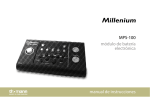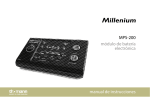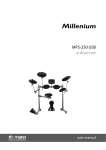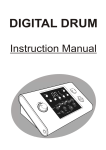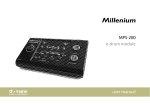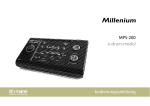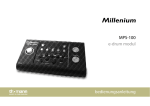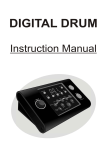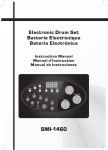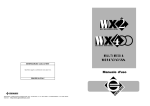Download MPS-100 e-drum module user manual
Transcript
MPS-100 e-drum module user manual Musikhaus Thomann Thomann GmbH Hans-Thomann-Straße 1 96138 Burgebrach Germany Telephone: +49 (0) 9546 9223-0 E-mail: [email protected] Internet: www.thomann.de 20.07.2015, ID: 254568 Table of contents Table of contents 1 General notes............................................................................................................................................... 5 2 Safety instructions..................................................................................................................................... 7 3 Features....................................................................................................................................................... 10 4 Installation.................................................................................................................................................. 11 5 Operating elements............................................................................................................................... 14 6 Operation.................................................................................................................................................... 20 6.1 Functions............................................................................................................................................. 20 6.2 Playing, customising and accompanying songs.................................................................. 23 6.3 Creating drum kits........................................................................................................................... 26 7 Technical specifications....................................................................................................................... 30 8 Cleaning....................................................................................................................................................... 32 9 Protecting the environment.............................................................................................................. 33 10 Appendix..................................................................................................................................................... 34 10.1 Voice list............................................................................................................................................ 34 MPS-100 3 Table of contents 10.2 Kit list.................................................................................................................................................. 40 10.3 Song list............................................................................................................................................. 41 10.4 MIDI implementation................................................................................................................... 44 e-drum module 4 General notes 1 General notes This user manual contains important information on safe operation of the device. Read and follow all safety notes and all instructions. Save this manual for future reference. Make sure that it is available to all persons using this device. If you sell the device to other users, be sure that they also receive this manual. Our products are subject to a process of continuous development. We therefore reserve the right to make changes without notice. Symbols and signal words This section provides an overview of the symbols and signal words used in this user manual. MPS-100 5 General notes Signal word Meaning DANGER! This combination of symbol and signal word indicates an immediate dangerous situation that will result in death or serious injury if it is not avoided. CAUTION! This combination of symbol and signal word indicates a pos‐ sible dangerous situation that can result in minor injury if it is not avoided. NOTICE! This combination of symbol and signal word indicates a pos‐ sible dangerous situation that can result in material and environmental damage if it is not avoided. Warning signs Type of danger Warning – danger zone. e-drum module 6 Safety instructions 2 Safety instructions Intended use Drum modules are intended to be used for converting digital trigger signals from drum pads to various percussion sounds. Use the unit only as described in this manual. Any other use or use under other operating conditions is considered to be improper and may result in personal injury or property damage. No liability will be assumed for damages resulting from improper use. This device may be used only by persons with sufficient physical, sensorial, and intellectual abilities and having corresponding knowledge and experience. Other persons may use this device only if they are supervised or instructed by a person who is responsible for their safety. MPS-100 7 Safety instructions Safety DANGER! Danger for children Ensure that plastic bags, packaging, etc. are disposed of properly and are not within reach of babies and young children. Choking hazard! Ensure that children do not detach any small parts (e.g. knobs or the like) from the unit. They could swallow the pieces and choke! Never let children unattended use electrical devices. CAUTION! Possible hearing damage With loudspeakers or headphones connected, the device can produce volume levels that may cause temporary or permanent hearing impairment. Do not operate the device permanently at a high volume level. Decrease the volume level immediately if you experience ringing in your ears or hearing impairment. e-drum module 8 Safety instructions NOTICE! Operating conditions This device has been designed for indoor use only. To prevent damage, never expose the device to any liquid or moisture. Avoid direct sunlight, heavy dirt, and strong vibrations. NOTICE! External power supply The device is powered by an external power supply. Before connecting the external power supply, ensure that the input voltage (AC outlet) matches the voltage rating of the device and that the AC outlet is protected by a residual cur‐ rent circuit breaker. Failure to do so could result in damage to the device and pos‐ sibly the user. Unplug the external power supply before electrical storms occur and when the device is unused for long periods of time to reduce the risk of electric shock or fire. MPS-100 9 Features 3 Features n n n n n 215 voices 20 pre-installed drum kits, 10 user kits 50 pre-installed songs Click and learning function Headphones, AUX and MIDI connections e-drum module 10 Installation 4 Installation Setup, connecting pads and pedals Setup and installation of the pads and pedals are described in detail in the included setup guide. Finally, check that all connecting cables between the pads and the drum module are connected correctly. Connecting the power supply Connect the supplied power adapter to the 9 V input of the device and then insert the mains plug into a mains wall outlet. Connecting headphones Connect your stereo headphones to the ‘PHONES’ output of the drum module. MPS-100 11 Installation Connecting audio devices Connect the inputs of your amplifier or powered speaker to the ‘OUTPUT’ sockets of the drum module. When using a mono amp, connect its input to the ‘L/MONO’ output socket of the module. Connecting MIDI devices Connect external MIDI devices to the ‘MIDI IN’ connections of the drum module. e-drum module 12 Installation Connecting CD or MP3 player Connect CD or MP3 player to the ‘AUX IN’ input of the drum module. MPS-100 13 Operating elements 5 Operating elements Front panel e-drum module 14 Operating elements 1 [volume] Volume control for headphones and line out. 2 [save] Button for saving settings. 3 [start/stop] Button for starting and pausing song playback. 4 [kit] Button for opening the kit menu. 5 [voice/volume] Button for opening the voice menu and for volume indication. 6 3-digit LED display. 7 [song/volume] Button for opening the song menu and for volume indication. MPS-100 15 Operating elements 8 [drum off] Button for muting the drum part. The indicator LED lights up, when the part is muted. 9 Indicator LED Flashes during playback according to metronome or current song beat. 10 [click] Button for turning the metronome on or off. 11 [–] / [+] Button for song and kit selection and for adjusting click and pad volume. 12 Pad selection field Buttons with integrated indicator LED for activating and playing the pads. 13 [tempo/tap –/+] Button for setting the metronome and playback speed. e-drum module 16 Operating elements Rear panel 14 midi out Connection for an external MIDI device. 15 Connection sockets for the pads. 16 – output – R / L/mono Output to connect active monitor speakers, mixer or power amp. MPS-100 17 Operating elements 17 aux.in Input for external audio devices like MP3 or CD player. 18 9V Connection socket for the power supply adapter. 19 ON / OFF Main switch to turn the device on or off. e-drum module 18 Operating elements Side view 20 phones Headphones socket. MPS-100 19 Operation 6 Operation 6.1 Functions Switching on Use the main switch [ON/OFF] on the rear panel to turn the unit on. Check for proper connection of all cables before switching the unit on. Before switching the unit on, turn the [volume] control down to minimum. Automatic switchoff – When the device is not used, it will switch off automatically after 30 minutes. To switch it on again, switch to the ‘OFF’ position and then to the ‘ON’ position. Deactivating the automatic switchoff – To deactivate the automatic switchoff, press and hold the [START/STOP] button while you switch on the device. e-drum module 20 Operation Adjusting the volume To set the volume, hit a pad while slowly turning the [volume] control clockwise. Selecting a drum kit A drum kit is a compilation in which each trigger is assigned to a certain sound and several sound parameters. By selecting a drum kit, you can tailor the sound of your e-drum kit in sec‐ onds to the desired style of music. In addition to the 20 preset drum kits, you can create and save 10 user drum kits (see Ä Chapter 10.2 ‘Kit list’ on page 40). Click function Press the [click] button to turn the Click function on or off. The indicator LED (9) of this button is lit when the Click is turned on. Use the [–] and [+] button to change the click volume. For this purpose, keep the [click] button pressed. The click volume is reset to the default value when the unit is switched off. Click speed can be adjusted in a range of 30 to 280 beats per minute using the [tempo/tap –/+] button. Press [–] or [+] briefly to increase or decrease the indicated value by one. Keep [–] or [+] pressed to increase or decrease the value quickly. MPS-100 21 Operation To reset the click speed to the default value ‘075’ press the middle of the [tempo/tap –/+] button. The click function can be turned on or off during playback. The click speed is automatically adjusted to the song speed during playback. Learning function With the learning function, you can practice each of the pre-installed songs according to your own pace. 1. Select the desired song as described here: Ä ‘Selecting a song’ on page 23. 2. Adjust the desired tempo as described here: Ä ‘Adjusting the playback speed’ on page 25. 3. Start the playback with [start/stop]. 4. Hit the pads synchronously to the indicator LED. e-drum module 22 Operation To turn the learning function (display of the pads played via indicator LEDs) on or off, press the buttons [hi-hat control] and [kick] simultaneously. 6.2 Playing, customising and accompanying songs Selecting a song Your digital drum module offers 50 pre-installed songs in total. When turning the drum module on, song ‘001’ is shown on the display by default. 1. Press the [song/volume] button. ð The display shows the song number and the Song LED lights up on the right below in the three-digit display. 2. Use the [–] and [+] to select the desired song (see Ä Chapter 10.3 ‘Song list’ on page 41). MPS-100 23 Operation Playing a song 1. Select the desired song as described above. 2. Start or stop the playback with [start/stop]. During playback, you can turn the Click on or off as desired. For this purpose, press the [click] button. During playback, the indicator LED of the pads played light up. Press the [hi-hat control] and [kick] buttons simultaneously to turn the function on or off. Adjusting song volume 1. Press the [song/volume] button. ð The song volume is indicated in ‘Axx’ format in the display, the Song LED on the right below in the three-digit display turns off. 2. Adjust the volume using the [–] and [+] buttons in a range of 00 to 31. e-drum module 24 Operation Adjusting the playback speed You can adjust the playback speed using the [tempo/tap –/+] button in a range of 30 to 280 beats per minute. Press the [–] or [+] briefly to increase or decrease the displayed value by one. Keep the [–] or [+] button pressed to increase or decrease the value quickly. To reset the playback speed to the default value (display value ‘065’ ) press the middle of the [tempo/tap –/+] button. After two seconds the display automatically returns to the song or kit number indica‐ tion. Tap-Timer (pre-count function) To accompany a song in your own tempo, the playback speed can be pre-counted using the Tap Timer function. 1. Select the desired song. 2. Press the [tempo/tap –/+] button. ð The default speed of the song is indicated in the display. 3. Hit any pad – just like pre-counting – four times. ð The drum module then accepts the tempo of the last two pre-count hits and the song is played with the pre-count speed. MPS-100 25 Operation During song playback, the Tap Timer function is not available. Muting the drum sound Any time during song playback, the drum track can be muted. 1. Press the [drum off] button, to mute the drum sound. ð The indicator LED lights up when the part is muted. 2. Press the [drum off] button again to unmute the drum track. 6.3 Creating drum kits The 215 pre-installed voices of the drum module can be freely programmed to the connected pads. In other words, you can create your own drum kits and store them in the unit. The fol‐ lowing sections describe how to create your own kits. e-drum module 26 Operation Assigning a voice To programme a certain voice to a pad, please proceed as follows: 1. Press the [voice/volume] button. ð The display indicates the current voice number. 2. Press the button of the pad you want to programme a certain voice for. Alternatively, you can directly activate the pad by playing it. ð The display shows the currently assigned voice. The indicator LED of the pad lights up. 3. Select the desired voice using the [–]/[+] button (see Ä Chapter 10.1 ‘Voice list’ on page 34). 4. Repeat steps 2 to 3 to assign the other pads as desired. MPS-100 27 Operation Adjusting the volume of the pads You may adjust the volume of the individual pads independently from the others. To do so, please proceed as follows: 1. Press the [voice/volume] button to change between voice number display and voice volume display. ð The display shows the current volume of the selected voice in ‘Lxx’ format. 2. Press the button of the pad whose volume you want to change. Alternatively, you can directly activate the pad by playing it. ð The indicator LED of the pad lights up. Storing settings 3. Adjust the volume using the [–]/[+] button. 4. Repeat steps 2 to 3 to adjust the volume of the other pads as desired. After you have assigned all the pads with the desired voices and adjusted the respective pad volume, you can save the settings as a user kit in the unit. To do so, please proceed as follows: 1. Press the [save] button. ð The display shows the first unused memory slot ( ‘021’ ). 2. Select the desired memory slot using the [–]/[+] button (range is 021 to 030). e-drum module 28 Operation 3. Press the [save] button again to save your user kit as the desired number. To cancel the storage process, press the button [voice/volume]. Any unsaved changes are discarded when you turn the drum module off. MPS-100 29 Technical specifications 7 Technical specifications Number of voices 215 Drum kits 20 preset kits 10 user kits Songs 50 preset songs e-drum module 30 Technical specifications Connections Headphones (1/4" phone socket) AUX in (1/4" phone socket) Mono/stereo outlet (1/4" phone socket) 1 × kick pad 1 × snare pad 3 × tom pads 2 × crash pads 1 × hi-hat 1 × hi-hat control MIDI out Operating voltage supply Power adapter (9 V ) MPS-100 31 Cleaning 8 Cleaning Device parts Clean the accessible parts of the device regularly. The frequency of cleaning depends on the operating environment: moist, smoky or particularly dirty environments may cause a higher accumulation of dirt on the components of the device. n n n n Use a dry soft cloth for cleaning. Remove stubborn stains with a slightly damp cloth. Never use cleaners containing alcohol or thinner. Never put any vinyl items on the device, as vinyl can stick to the surface or lead to its disco‐ louration. e-drum module 32 Protecting the environment 9 Protecting the environment Disposal of the packaging mate‐ rial For the transport and protective packaging, environmentally friendly materials have been chosen that can be supplied to normal recycling. Ensure that plastic bags, packaging, etc. are properly disposed of. Do not just dispose of these materials with your normal household waste, but make sure that they are collected for recycling. Please follow the notes and markings on the packaging. Disposal of your old device This product is subject to the European Waste Electrical and Electronic Equipment Directive (WEEE). Do not dispose with your normal household waste. Dispose of this device through an approved waste disposal firm or through your local waste facility. When discarding the device, comply with the rules and regulations that apply in your country. If in doubt, consult your local waste disposal facility. MPS-100 33 Appendix 10 10.1 Nr. Appendix Voice list Name Nr. Name Nr. Name Acoustic Bass Drum 009 Lo BD 017 BD-Analg 001 BD Head 010 Rock BD 1 018 MrDance 1 002 Real BD 1 011 Rock BD 3 019 MrDance 2 003 Real BD 2 012 Rock BD 4 020 MrDance 5 004 Real BD 6 013 BD-Var 3 021 Lo-BD 1 005 BD Std 1 014 BD-Var 5 022 Lo-BD 2 006 BD Std 2 015 Big Drum 1 023 Hard BD 3 007 Room BD 1 016 Big Drum 2 Acoustic Snare Drum 008 Room BD 2 Electronic Bass Drum e-drum module 34 024 SD-Std 1 Appendix Nr. Name Nr. Name Nr. Name 025 SD-Std 2 038 SD-Std 22 051 SidStik 1 026 SD-Std 3 039 SD-Std 23 052 SidStik 2 027 SD-Std 4 040 SD-Std 24 053 SnarTimb 028 SD-Std 5 041 SD-Std 25 054 RowDrum 1 029 SD-R 1 042 SD-Std 26 055 RowDrum 2 030 SD-R 2 043 SD-Std 27 056 RowDrum 3 031 SD-R 5 044 SD-Std 28 Electronic Snare Drum 032 Snare 1 045 SD-Std 29 057 SD-Ana 2 033 Snare 2 046 SnareDr 1 058 SD-Ana 6 034 Snare 4 047 SnareDr 5 059 SD-Ana 7 035 Snare 5 048 SnareDr 6 060 SD-Ana 11 036 Snare 6 049 SnareDr 7 061 SD-Danc 5 037 SD-Std 21 050 SnareDr 8 062 SD-Danc 6 MPS-100 35 Appendix Nr. Name Nr. Name Nr. Name 063 SD-Elec 076 Brush 10 088 Tom-BRK H 064 Syn-SD 1 077 Brush 13 089 Tom-BRK M 065 Syn-SD 7 Acoustic Tom 090 Tom-BRK L 066 Syn-SD 8 078 Tom-Std 5 091 Tom-BRK F 067 Syn-SD 11 079 Tom-Std 3 092 Tom-Rom 6 068 Cool-SD 1 080 Tom-Std 2 093 Tom-Rom 5 069 HD-SD 1 081 Tom-Std 1 094 Tom-Rom 4 070 Brush 1 082 Tom-Jaz M 095 Tom-Rom 3 071 Brush 2 083 Tom-Jaz F 096 Tom-Rom 2 072 Brush 3 084 Tom-Brs H 097 Tom-Rom 1 073 Brush 5 085 Tom-Brs M 098 Tom-Rm 2 L 074 Brush 7 086 Tom-Brs L 099 Tom-Rm 2 F 075 Brush 8 087 Tom-Brs F Electronic Tom e-drum module 36 Appendix Nr. Name Nr. 100 TomH-A Cymbal 101 Tom-A 5 113 102 Tom-A 4 103 Name Nr. Name 125 RideBStd CrashStd 126 Splash C 1 114 CrashBrt 127 Cymbel 2 Tom-A 3 115 CrashSt 2 128 Cymbel 3 104 Tom-A 2 116 SftCrash 129 BigGong 1 105 Tom-A 1 117 CrashSt 3 130 BigGong 2 106 Tom-T 1 M 118 CrashSht 131 B.Cymbl 1 107 Tom-T 3 L 119 CrshThin 132 B.Cymbl 2 108 Tom-T 3 F 120 CrashRev 133 S.Cymbl 2 109 Tom-El 4 121 CrashRol 134 S.Cymb 2 M 110 Tom-El 3 122 CrashSt 4 135 SmalGong 111 Tom-El 2 123 RideBel 1 Hi-Hat 112 Tom-El 1 124 RK Ride 2 136 H.H Cls 1 MPS-100 37 Appendix Nr. Name Nr. Name Nr. Name 137 H.H Cls 3 150 Ana Hh 1 162 Conga-Hi 138 H.H Cls 4 Percussion 163 Conga-M 1 139 H.H Opn 1 151 Agogo-1 164 Conga-M 2 140 H.HCNor 1 152 Agogo-2 165 Conga-3 141 RK HHcls 153 Bell Tre 166 Conga-4 142 H.H Opn 3 154 Bongo Hi 167 Conga-5 143 Open HH 2 155 Bongo Lo 168 CowBell 1 144 Open HH 3 156 Cabasa 1 169 CowBell 2 145 Open HH 4 157 Cabasa 2 170 Cuica H 146 RK HHOpn 158 Castanet 171 Cuica L 147 Open HH 7 159 ClapA 172 Fsnap 148 HH pedl 1 160 Clavis 1 173 Guiro 1 149 HH pedl 2 161 Clavis 2 174 Guiro 2 e-drum module 38 Appendix Nr. Name Nr. Name Nr. Name 175 HiQ 188 Tabla 4 201 Whistal 176 JingBell 189 TalkD 202 XfadeTri 177 Maracas 1 190 TalknDrD 203 Smallwod 178 Maracas 2 191 TalknDrU 204 BoardDr 1 179 MetroBel 192 TalknDrV 205 BoardDr 2 180 MetroClk 193 Tambouri 206 LotusBrd 181 Scrach 194 TimbleH 207 BanbuBrd 182 Shake 195 TimbleL 208 SouthBan 183 Surdo 1 196 TimblePH 209 B.WdFish 184 Surdo 2 197 TimblePL 210 S.WdFis 1 185 Tabla 1 198 Triangle 211 S.WdFis 2 186 Tabla 2 199 TriagMut 212 S.WdFis 3 187 Tabla 3 200 VibrSlap 213 S.WdFis 4 MPS-100 39 Appendix Nr. Name Nr. Name 214 ImpacBel 215 ImpaBel M 10.2 Nr. Kit list Nr. Name Nr. Name 001 Standard 1 008 Room Stick 002 Standard 2 009 Latin 1 003 Dance 1 010 Latin 2 004 Jazz Latin 011 Jazz 005 Room 1 012 Brush 2 006 Electric 013 Dance Stick 007 Brush 014 Orchestra e-drum module 40 Name Appendix Nr. Name Nr. Name 015 Drum & Bass 018 Ungle 016 House 019 China LuoGu 017 Rhythm & Blues 020 Oriental 1 10.3 Song list Nr. Name Takt Nr. Name Takt 001 Guitar 4/4 006 Newage 4/4 002 Accordion Fusion 4/4 007 Reggae Funk 4/4 003 Folk Pop 4/4 008 Drum & Bass 4/4 004 Rock 4/4 009 Pop 8 Beat 4/4 005 Blues 4/4 010 Dance 4/4 MPS-100 41 Appendix Nr. Name Takt Nr. Name Takt 011 Drk -2 4/4 023 Rock Pop 4 4/4 012 Pop 3 4/4 024 Latin 4 4/4 013 Pop 5 4/4 025 Latin 5 4/4 014 Jazz 1 4/4 026 Reggae 4/4 015 Rhythm & Blues 4 6/8 027 Shuffle 1 4/4 016 Ballad 1 4/4 028 Rhythm & Blues 3 4/4 017 Ballad 2 4/4 029 Rock 'N' Roll 1 4/4 018 Ballad 4 4/4 030 8 Beat 4 4/4 019 Ballad 5 4/4 031 8 Beat 2 4/4 020 Ballad 6 4/4 032 16 Beat 4/4 021 Waltz 3/4 033 March 4/4 022 Slow Rock 6/8, 9/8 034 Latin 6 4/4 e-drum module 42 Appendix Nr. Name Takt Nr. Name Takt 035 Funk 3 4/4 043 Dance 1 4/4 036 Fusion 2 4/4 044 Dance 2 4/4 037 Rock 'N' Roll 2 4/4 045 Mambo 4/4 038 Hard Rock 3 4/4 046 Rhythm & Blues 1 4/4 039 Rock Pop 2 4/4 047 Rhythm & Blues 2 4/4 040 Funk 1 4/4 048 Ballad 3 4/4 041 Funk 4 4/4 049 Jing Opera 4/4 042 Jazz 3 6/8 050 Chinese Rhythm 2/4 MPS-100 43 Appendix 10.4 MIDI implementation Function Basic channel Mode Note number Transmitted Default Ch 10 Changed No Default No Messages No Altered ******** True voice 0…127 ******** Velocity Aftertouch Note ON Yes (9nH, V=1…127) Note OFF No (9nH. V=0) Keys No Channels No e-drum module 44 Remarks Appendix Function Transmitted Pitch bender No Control change Remarks 0 No Bank select 1 No Modulation 5 No Portamento time 6 No Data entry 7 No Volume 10 No Pan 11 No Expression 64 No Sustain pedal 65 No Portamento ON/OFF 66 No Sostenuto pedal 67 No Soft pedal 80 No Reverb program MPS-100 45 Appendix Function Transmitted Remarks 81 No Chorus program 91 No Reverb level 93 No Chorus level 120 No All Sound Off 121 No Reset All Controllers 123 No All Notes Off Program change No True # System exclusive System common System real time No No Song Position No Song Select No Tune No Clock No e-drum module 46 Appendix Function Aux messages Transmitted Command No Local ON/OFF No All Notes OFF No Active Sense No System reset No Remarks MPS-100 47 Notes e-drum module 48 Notes MPS-100 49 Notes e-drum module 50 Musikhaus Thomann · Hans-Thomann-Straße 1 · 96138 Burgebrach · Germany · www.thomann.de




















































